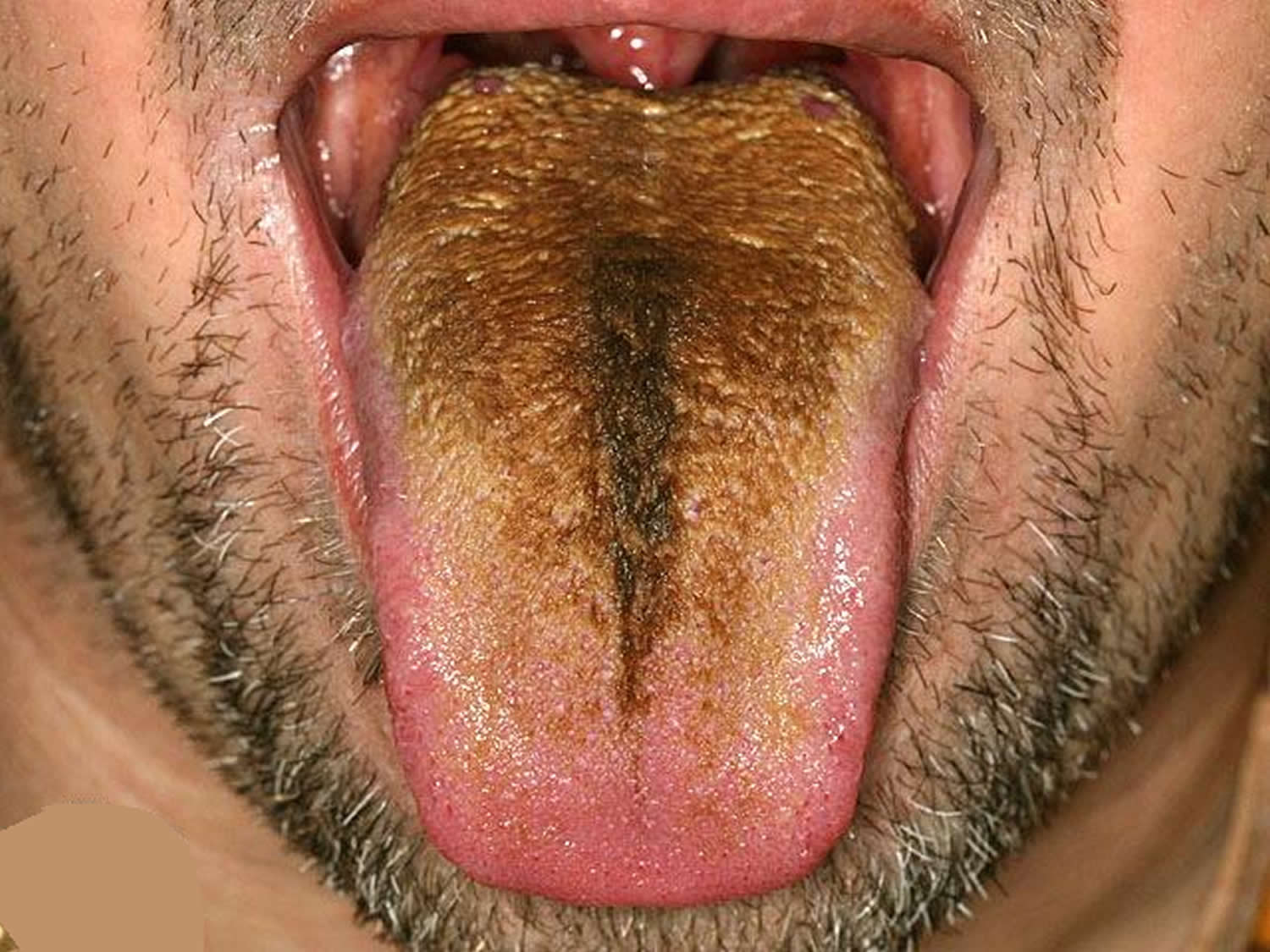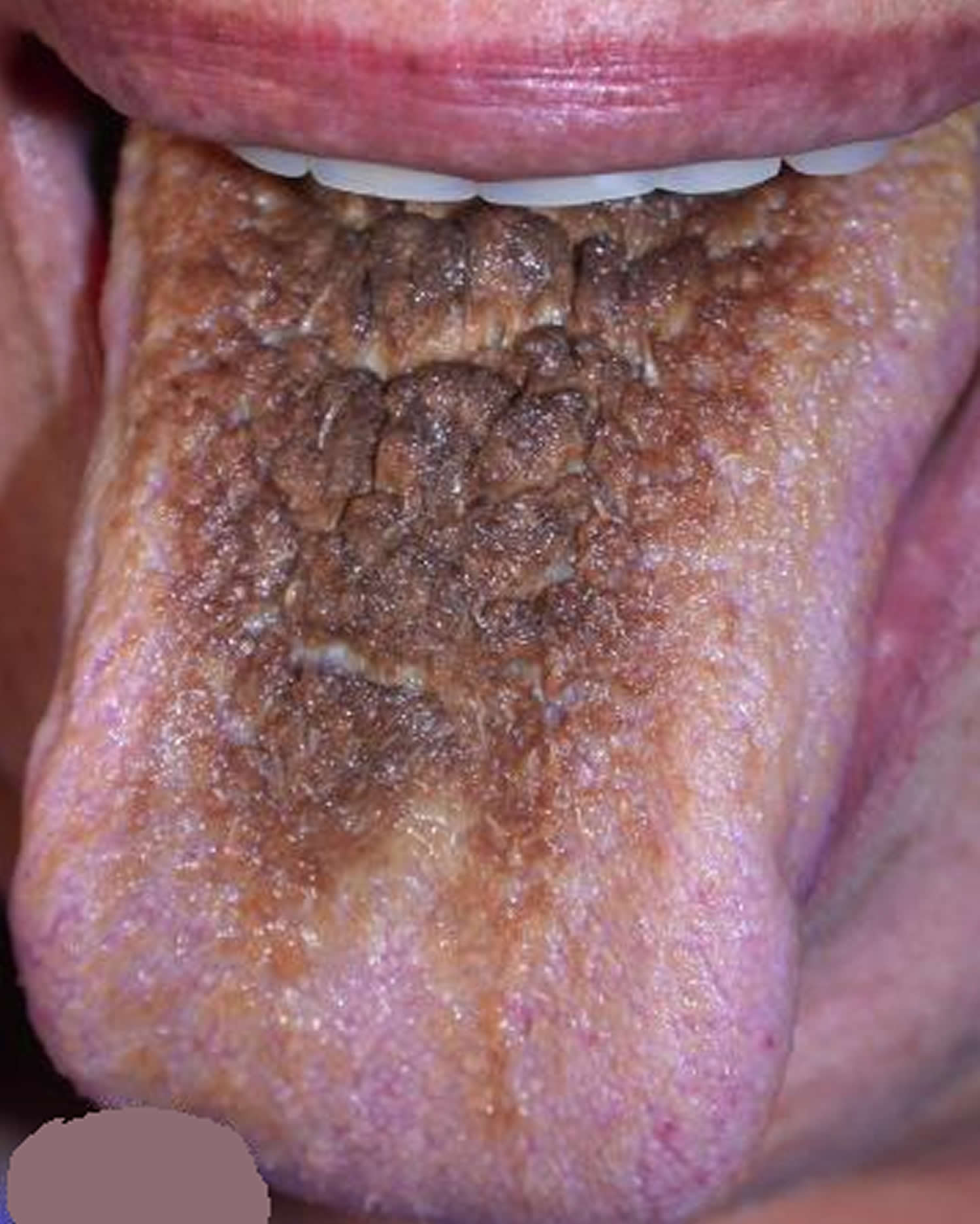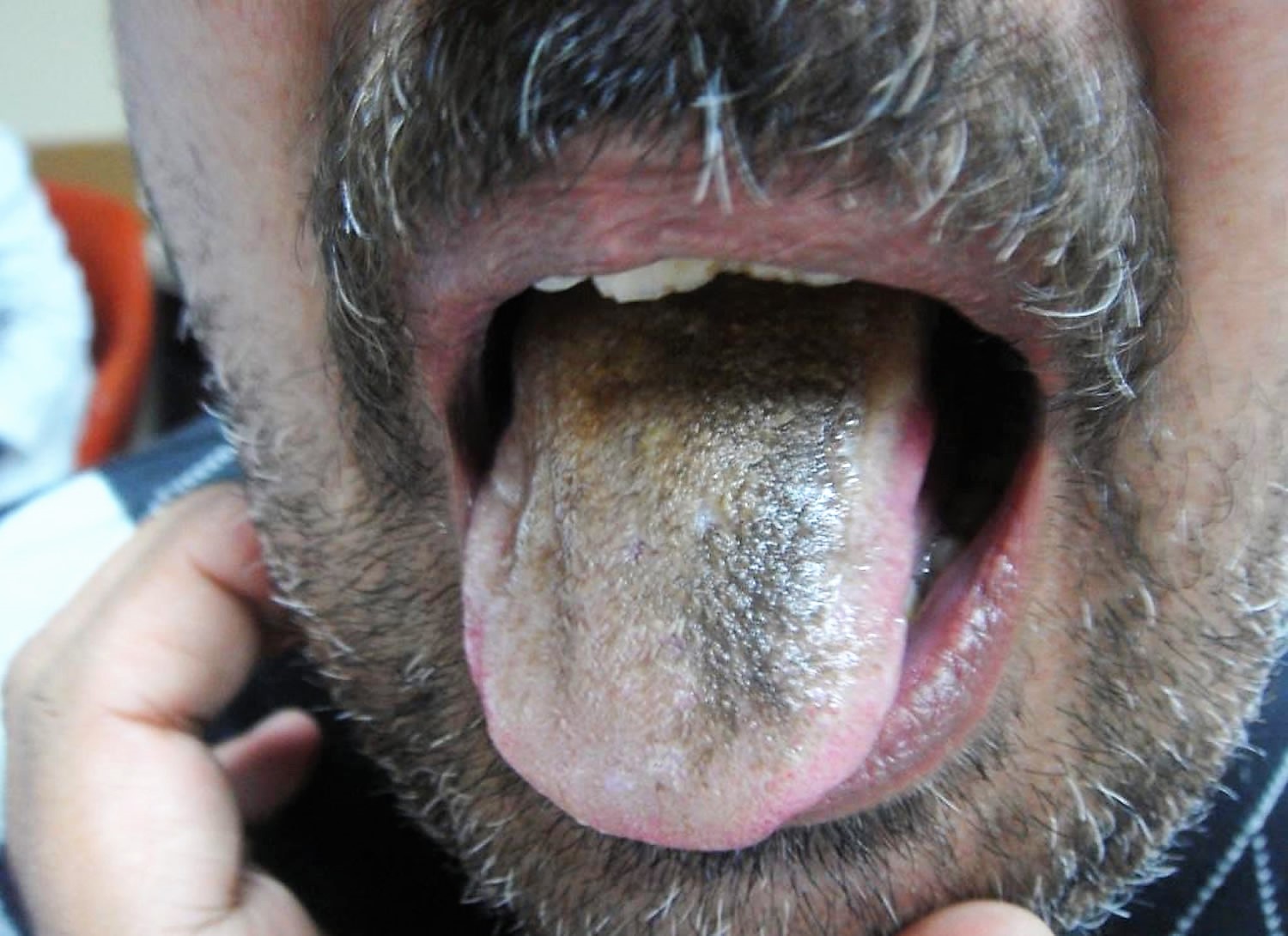Contents
What is black hairy tongue
Black hairy tongue is an acquired, benign (harmless) medical condition characterized by hypertrophied and elongated filiform lingual papillae (finger-like projections from the surface of the tongue) with typical carpet-like appearance of the surface of the tongue fail to fall off as they normally do 1. As the length of the papilla increase, debris collects and bacteria grow, producing the characteristic dark “furry” appearance. Hairy tongue may also appear brown, yellow, green, blue, or even unpigmented 2.
Accumulation of excess keratin on the filiform papillae of the dorsal tongue leads to the formation of elongated strands that resemble hair. The color of the tongue can range from white or tan to black (black hairy tongue). Black hairy tongue results from the trapping of debris and bacteria in the elongated strands (Figures 1, 2, 3 and 4). This occurs most commonly in smokers and in persons with poor oral hygiene 3. Hairy tongue has been associated with use of certain antibiotic medications 4. Most patients are asymptomatic, but some have halitosis or abnormal taste. No treatment is required, but gentle daily debridement with a tongue scraper or soft toothbrush can remove keratinized tissue 5.
The long-term outcomes for black hairy tongue are excellent as the disease is benign and may even improve spontaneously. Review of the literature shows prompt resolution of this condition within days to few weeks after mechanical debridement and removal of a suspected precipitating agent 1. Patient education on proper oral hygiene and lifestyle modifications including smoking cessation and alcohol abstinence are vital to preventing reoccurrence.
Black hairy tongue typically causes aesthetic concerns to the patient and leads to frequent physician visits. It may, however, be rarely associated with gagging, nausea, dysgeusia (distortion of the sense of taste), xerostomia, burning mouth syndrome and halitosis in some patients 6 a constellation of symptoms that, in clinical practice, frequently leads to an evaluation by a gastroenterologist.
Black hairy tongue prevalence varies geographically, typically ranging from 0.6% to 11.3%. Known predisposing factors include smoking, excessive coffee/black tea consumption, poor oral hygiene, trigeminal neuralgia, general debilitation, xerostomia, and medication use. Clinical presentation varies but is typically asymptomatic, although aesthetic concerns are common. Differential diagnosis includes pseudo-black hairy tongue, acanthosis nigricans, oral hairy leukoplakia, pigmented fungiform papillae of the tongue, and congenital melanocytic/melanotic nevi/macules. Clinical diagnosis relies on visual observation, detailed history taking, and occasionally microscopic evaluation. Treatment involves identification and discontinuation of the offending agent, modifications of chronic predisposing factors, patient’s re-assurance to the benign nature of the condition, and maintenance of adequate oral hygiene with gentle debridement to promote desquamation. Complications of black hairy tongue (burning mouth syndrome, halitosis, nausea, gagging, dysgeusia) typically respond to therapy. Prognosis is excellent with treatment of underlying medical conditions. Black hairy tongue remains an important medical condition which may result in additional burden on the patient and health care system and requires appropriate prevention, recognition and treatment.
Though unattractive, black hairy tongue is usually a temporary, harmless condition.
See your doctor if:
- You’re concerned about the appearance of your tongue
- Black hairy tongue persists despite brushing your teeth and tongue twice daily
Figure 1. Tongue anatomy
Figure 3. Black hairy tongue
Figure 4. Black hairy tongue
Differential diagnosis
Classic black hairy tongue presents as a black, hairy-appearing lesion on the surface of the tongue. Differential diagnosis includes “pseudo-hairy tongue”, oral hairy leukoplakia, pigmented fungiform papillae of the tongue and acanthosis nigricans 7. “Pseudo-black hairy tongue” (Figure 5) appears as a darkly stained tongue in absence of elongated filiform papillae seen in black hairy tongue. Foods, tobacco, and drugs, including antibiotics, antidepressants, and bismuth salicylate, can cause this condition 6. Oral hairy leukoplakia can be seen in the immunocompromised patients and has a white plaque appearance on the dorsal and ventral surfaces of the tongue, as well as buccal mucosa, and gingiva. Pigmented (due to melanin laden macrophages) fungiform papillae are rare, characterized by isolated hypertrophied lesions primarily on the lateral aspect and apex of the tongue that has a predilection to dark skinned patients. Acanthosis nigricans in the oral cavity manifests as multiple dark and demarcated papillary lesions on the dorsum and lateral region of the tongue with frequent labial involvement and may be associated with underlying malignancy 7. Detailed history and physical exam is essential to arriving at the correct diagnosis, with particular emphasis on identifying known etiologic factors. If dubious, biopsy specimens may be required to exclude “mimicking” conditions and confirm the diagnosis. In infants, congenital lingual melanotic macules and congenital melanocytic nevi should be sought for and diligently excluded 2.
Figure 5. Pseudo-black hairy tongue
Note: Pseudo black hairy tongue with bismuth salicylate use
Black hairy tongue causes
Black hairy tongue is due to defective shedding of surface cells. Abnormal filiform papillae prevent normal cleaning and debridement of the tongue, hence debris accumulates. Bacteria and yeasts then overgrow and make porphyrins (deeply coloured organic compounds), which may contribute to the discoloration 8.
The cause of black hairy tongue remains unclear and is likely multifactorial, resulting from combination of local and systemic insults.
Although the cause of black hairy tongue can’t always be determined, possible causes or contributing factors include:
- Changes in the normal bacteria or yeast content of the mouth after antibiotic use
- Poor oral hygiene
- Dry mouth (xerostomia)
- Regular use of mouthwashes containing irritating oxidizing agents, such as peroxide
- Tobacco use
- Drinking excessive amounts of coffee or black tea
- Excessive alcohol use
- Eating a soft diet that doesn’t help to rub dead skin cells from your tongue
The appearance of the hairy tongue likely originates in differences in potentially contributing extrinsic (environmental) and intrinsic (chromogenic oral microflora) factors 2. Although casual smoking poses a slightly increased risk of having black hairy tongue compared to non-smokers (15% to 10% in men, 5.5% to 5.2% in women), heavy use of tobacco leads to estimated prevalence of 58% in men and 33% in women 9. Similar to smoking, heavy black tea consumption lead to increased prevalence of black hairy tongue in both male and female patients 9. Alcohol and intravenous drug use, excessive coffee consumption, poor oral hygiene, general debilitation, and recent radiation therapy to the head and neck region are important risk factors that predispose some patients to develop black hairy tongue 6. Prolonged use of oxidizing mouthwashes containing sodium perborate, sodium peroxide, and hydrogen peroxide has also been associated with the development of black hairy tongue 10. Dietary consumption of herbal tea and sugars may lead to lowering pH on the dorsum of the tongue promoting chromogenic bacterial overgrowth 2. Most recently, a number of cases of black hairy tongue have been reported after allogenic stem-cell transplantation as a cutaneous presentation of graft-versus-host-disease 11. Finally, prevalence of black hairy tongue is increased in malignancies, with one study showing rates as high as 30% in men and 18% in women 12. Debates on causative relationship between microbial infection and development of black hairy tongue date back to 1869 and although previously linked to the presence of various microbial agents, including Candida and Aspergillus species in the oral cavity, microflora found in black hairy tongue may be largely coincidental rather than causative 10.
Use of systemic and local medications has been commonly implicated in the development of black hairy tongue. Antibiotics, including penicillin, aureomycin, erythromycin, doxycycline, and neomycin are most often associated with this disorder 13. However, it should be noted that the cause and effect factor between antibiotics and development of black hairy tongue needs to be further elucidated. Specifically, local or systemic antibiotic use may significantly alter oral flora, thus potentially predisposing the patient to develop black hairy tongue. On the other hand, pronounced anatomical alteration in the filiform papillae may predispose the patient to trap foreign material and stimulate local microbial overgrowth that leads to typical color changes seen in patients with this condition. Importantly, earlier studies linking black hairy tongue to the use of antibiotics reported local (aerosol or lozenges) oral penicillin use, a type of medication not used in today’s medical practice 6. Additionally, xerostomie agents, including antipsychotics (olanzapine and chlorpromazine) may predispose patients to develop black hairy tongue 14. Particular care should be delegated in identifying local inciting factors in the development of black hairy tongue, including recent use of new toothpaste or mouthwash 6. Interestingly, a case of black hairy tongue was also reported after four days of erlotinib treatment in a patient with advanced lung cancer, possibly due to an unclear interruption of epidermal grown factor and its receptor in the lingual epithelium 15.
Other diseases and medical conditions associated with black hairy tongue include HIV, advanced cancer, and general body illness 6. In addition, black hairy tongue has been reported in patients with trigeminal neuralgia. This painful condition, associated with poor oral intake and decreased mastication, is thought to limit tongue movement, resulting in decreased tongue friction with food, palate, and teeth and ultimately hindering normal desquamation of the keratinized filiform papillae, thus leading to the development of black hairy tongue 16.
Black hairy tongue symptoms
Signs and symptoms of black hairy tongue include:
- Black discoloration of the tongue, although the color may be brown, tan, green, yellow or white
- A hairy or furry appearance of the tongue
- Altered taste or metallic taste in your mouth
- Bad breath (halitosis)
- Gagging or tickling sensation, if the overgrowth of the papillae is excessive
Black hairy tongue diagnosis
Diagnosis of black hairy tongue is based on appearance 17 and possible causes or contributing factors. It also includes eliminating other conditions that may cause a similar appearance to the tongue, such as:
- Normal variations in tongue color (pigment)
- Foods or medications that have stained the tongue
- Fungal or viral infections
- Oral lesions that occur on the tongue, such as oral hairy leukoplakia
- Blackened tongue (pseudo-black hairy tongue) from using products containing bismuth, such as Pepto-Bismol
A typical patient with black hairy tongue is an elderly male smoker on antibiotics or antipsychotics with poor oral hygiene, who presents with painless black hair-like lesion on the surface of the tongue anterior to the circumvallate papillae. It generally does not occur on the tip or sides of the tongue. Although recognized for its distinctive black color, its hue can range from blackish-brown to yellow-green to unpigmented[7,12]. black hairy tongue is generally asymptomatic, though metallic taste, dysgeusia, burning mouth, halitosis, and even gagging have been reported in some patients[31]. Submandibular or cervical lymphadenopathy may occasionally be present in selected cases[2]. Review of systems may be significant for chronic pain, major physical disabilities, psychiatric illnesses, or other debilitating symptoms that preclude the maintenance of proper oral hygiene and normal tongue movement. Other associated clinical conditions include smoking, advanced malignancy, psychiatric conditions, and trigeminal neuralgia. Physical exam is unremarkable aside from the hairy appearing tongue lesion itself. Associated laboratory findings may include positive fungal cultures, HIV test, and blood and urine toxicology studies.
Black hairy tongue treatment
Black hairy tongue typically doesn’t require medical treatment. Though unattractive, it’s a temporary, harmless condition.
If desired, treatment options include:
- Discontinuing responsible drugs
- Avoiding smoking and excessive alcohol intake
- Encouraging good oral hygiene
- Gentle tongue debridement, with a tongue scraper or soft toothbrush and solution containing 3% hydrogen peroxide or baking soda [1]
- Antiseptic mouthwash
- Topical antifungal agent for oral Candida albicans if present
- Topical retinoid
If other treatment fails, trimming papillae by carbon dioxide laser burning and electrodessication have been described.5
Practicing good oral hygiene and eliminating factors that may contribute to the condition — such as avoiding tobacco use or irritating mouthwashes — help resolve black hairy tongue. Be sure to talk to your doctor or dentist before stopping a prescribed medication.
Lifestyle modifications, including increased dietary consumption of raw fruits and vegetables may help improve this condition by facilitating the roughage on the tongue 14.
Yogurt and probiotic supplementation may be employed with various degree of success. Candida associated glossopyrosis should be treated with antifungal medications. Routine use of proton pump inhibitors is not indicated, although may be of benefit in cases with concomitant severe gastroesophageal reflux disease.
Anecdotal use of antimicrobial therapies, topical triamcinolone acetonide, gentian violet, salicylic acid, vitamin B complex, thymol, and topical or oral retinoids (e.g., isotretinoin), as well as keratin olytics (podophyllin), topical 30% urea solution, and trichloroacetic acid have been reported in the literature, although potential side effects from local irritation and possible systemic absorption are important factors to consider 18, 19, 20.
Resistant black hairy tongue may require clipping or removal of the papillae by electrodessication or carbon dioxide laser 7.
Black hairy tongue home remedies
To practice good oral health and to remove the tongue discoloration:
- Brush your tongue. Give your tongue a gentle brushing whenever you brush your teeth to remove dead cells, bacteria and food debris. Use a soft-bristled toothbrush or a flexible tongue scraper.
- Brush after eating. Brush your teeth at least twice a day and ideally after every meal, using fluoride toothpaste.
- Floss at least once a day. Proper flossing removes food particles and plaque from between your teeth.
- Visit your dentist regularly. Get professional teeth cleanings and regular oral exams, which can help your dentist prevent problems or spot them early. Your dentist can recommend a schedule for you.
- Maintain good nutrition. Drink plenty of water and eat a balanced diet that contains fresh fruits and vegetables.
- Gurvits GE, Tan A. Black hairy tongue syndrome. World Journal of Gastroenterology : WJG. 2014;20(31):10845-10850. doi:10.3748/wjg.v20.i31.10845. https://www.ncbi.nlm.nih.gov/pmc/articles/PMC4138463/[↩][↩]
- Poulopoulos AK, Antoniades DZ, Epivatianos A, Grivea IN, Syrogiannopoulos GA. Black hairy tongue in a 2-month-old infant. J Paediatr Child Health. 2008;44:377–379. https://www.ncbi.nlm.nih.gov/pubmed/18476933[↩][↩][↩][↩]
- Joseph BK, Savage NW. Tongue pathology. Clin Dermatol. 2000;18(5):613–618.[↩]
- McGrath EE, Bardsley P, Basran G. Black hairy tongue: what is your call? CMAJ. 2008;178(9):1137–1138.[↩]
- Byrd JA, Bruce AJ, Rogers RS III. Glossitis and other tongue disorders. Dermatol Clin. 2003;21(1):123–134.[↩]
- Thompson DF, Kessler TL. Drug-induced black hairy tongue. Pharmacotherapy. 2010;30:585–593. https://www.ncbi.nlm.nih.gov/pubmed/20500047[↩][↩][↩][↩][↩][↩]
- McGrath EE, Bardsley P, Basran G. Black hairy tongue: what is your call? CMAJ. 2008;178:1137–1138. https://www.ncbi.nlm.nih.gov/pmc/articles/PMC2292769/[↩][↩][↩]
- McGrath EE, Bardsley P, Basran G. Black hairy tongue: What is your call? CMAJ : Canadian Medical Association Journal. 2008;178(9):1137-1138. doi:10.1503/cmaj.071611. https://www.ncbi.nlm.nih.gov/pmc/articles/PMC2292769/[↩]
- Avcu N, Kanli A. The prevalence of tongue lesions in 5150 Turkish dental outpatients. Oral Dis. 2003;9:188–195. https://www.ncbi.nlm.nih.gov/pubmed/12974518[↩][↩]
- Sarti GM, Haddy RI, Schaffer D, Kihm J. Black hairy tongue. Am Fam Physician. 1990;41:1751–1755. https://www.ncbi.nlm.nih.gov/pubmed/2190456[↩][↩]
- Akay BN, Sanli H, Topcuoglu P, Zincircioğlu G, Gurgan C, Heper AO. Black hairy tongue after allogeneic stem cell transplantation: an unrecognized cutaneous presentation of graft-versus-host disease. Transplant Proc. 2010;42:4603–4607. https://www.ncbi.nlm.nih.gov/pubmed/21168745[↩]
- Farman AG. Hairy tongue (lingua villosa) J Oral Med. 1977;32:85–91. https://www.ncbi.nlm.nih.gov/pubmed/20488[↩]
- Jover-Diaz F, Cuadrado-Pastor JM, Talents-Bolos A, Martin-Gonzalez C. Black tongue associated with linezolid. Am J Ther. 2010;17:e115–e117. https://www.ncbi.nlm.nih.gov/pubmed/20634649[↩]
- Tamam L, Annagur BB. Black hairy tongue associated with olanzapine treatment: a case report. Mt Sinai J Med. 2006;73:891–894. https://www.ncbi.nlm.nih.gov/pubmed/17117318[↩][↩]
- Jeong JS, Lee JY, Kim MK, Yoon TY. Black hairy tongue associated with erlotinib treatment in a patient with advanced lung cancer. Ann Dermatol. 2011;23:526–528. https://www.ncbi.nlm.nih.gov/pmc/articles/PMC3229953/[↩]
- Cheshire WP. Unilateral black hairy tongue in trigeminal neuralgia. Headache. 2004;44:908–910. https://www.ncbi.nlm.nih.gov/pubmed/15447700[↩]
- Architectural organization of filiform papillae in normal and black hairy tongue epithelium: dissection of differentiation pathways in a complex human epithelium according to their patterns of keratin expression. Arch Dermatol. 1999 Feb;135(2):177-81. https://jamanetwork.com/journals/jamadermatology/fullarticle/477720[↩]
- Ramsakal A, Mangat L. Images in clinical medicine. Lingua villosa nigra. N Engl J Med. 2007;357:2388. http://www.nejm.org/doi/full/10.1056/NEJMicm065655[↩]
- Langtry JA, Carr MM, Steele MC, Ive FA. Topical tretinoin: a new treatment for black hairy tongue (lingua villosa nigra) Clin Exp Dermatol. 1992;17:163–164. https://www.ncbi.nlm.nih.gov/pubmed/1451290[↩]
- Weinstein I, Rosencrans M. Treatment of black hairy tongue with triamcinolone acetonide. Report of a case. Oral Surg Oral Med Oral Pathol. 1962;15:1071–1074. https://www.ncbi.nlm.nih.gov/pubmed/14005759[↩]









